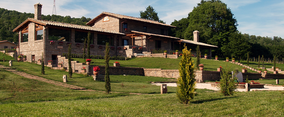Residenza Rocca Romana – Trevignano Romano
SHANKHA PRAKSHALANA
30-31 March 2019
SHANKHA PRAKSHALANA PRACTICE
Spring is coming, and our whole body starts reawakening from winter numbness, in order to set itself up for the energy of the Sun.
In this period, the best thing we can do for our health consists in cleaning in particular our liver, bowels and kidneys.
Indian culture offers the practice of Shankha Prakshalana, one of the ancient yoga Kriya methods.
Through Shankha Prakshalana, we clean not only our bowels, but also our whole digestive system, from the mouth down to urethra/anus.
This yoga practice allows us to clean up our bowels in an effective way, removing anything left in our digestive organs, cleanses our blood, thus freeing our bloodstream from toxins, lets our skin breathe, and become once again soft, flexible and bright. Naturally, digestive problems such as hyperacidity, flatulence, stomach ache, indigestion, will be remarkably improved by this cleaning practice. Sleep and blood pressure might also be rebalanced.
Shankha Prakshalana means “shell cleaning” (“shank”, shell, probably refers to the coiled shape of our bowels, or to the fact that water flows into our body as inside a shell). It is a clean-up of the whole digestive circuit with hot salt water.
BEFORE STARTING YOUR BOWEL CLEANING
You should start preparing for this practice at least 2-3 days beforehand, gradually reducing the food you eat, and replacing it with fresh fruit and vegetables.
Shankha Prakshalasana starts already with the dinner before the cleaning. We suggest a light meal: a fruit or a soup. The next morning, you will skip breakfast.
Shankha Prakshalana requires salted water, which – through a few yoga asanas, will flow freely through both stomach and bowels.
This wash may fail the first time, but you should not lose heart because of this.
Once you conclude the practice, you should eat well-cooked white (not brown) rice, with butter, and you can drink fresh water with it (not before eating).
You should rest in the afternoon, and it would be better to follow a light diet in the following days, with steamed vegetables, and fruits with a minimum sugar content. You might want to take lactic ferments in order to restore bacterial flora.
BENEFITS
This practice provides many benefits:
· A complete deep cleaning of your intestine from dregs built up over time
· A general purification of the organs of the digestive tract, thus improving food absorption
· Improved functions of both intestine and stomach
· Reduced intestinal ailments, such as: constipation, colitis, etc…
CONTRA-INDICATION
Just like any relevant practice, Shankha Prakshalana has a few contra-indications.
This practice is reserved to healthy people. It is highly inadvisable in case of: gastric ulcer; dysentery and other acute disorders of the digestive tract; tubercolosis; bowel cancer; menstrual period; pregnancy and breast-feeding; tachycardia, heart attack.
AFTER THE PRACTICE OF INTESTINE CLEANING
A correct diet is a key element for both a good preparation and a suitable recovery of intestinal activity.
This practice, by often stimulating evacuation during the day, and sometimes even the following day, povokes an intense activity of the intestine, thus inducing a minor inflammation in its mucosa: that is why, at this stage, food may reduce this inflammation, cure the mucosa, and recreate the layer of protective mucus and healthy bacterial flora which have been "washed away".
In the day of the practice, after the cleaning, you need to drink plenty of fresh water in order to rehydrate, and eat rice with butter.
In the evening after the practice, you may eat fruits after the rice.
- Starting from the following day, you can eat something more, namely: rice, steamed vegetables, and fresh fruit whenever you are hungry.
- The day after, together with rice, vegetables, fruit, you may add miso soup, the best thing together with brown rice: miso, a paste made from fermented soya beans, or rice, barley and other legumes/cereals will help restore your bacterial flora . It must be melted into the soup at the end, when the cooker is off, and stir quickly before serving, so as not to damage the live bacteria it contains.
We suggest that you continue following a vegetarian diet for a few days, since animal proteins might overburden your detoxed intestine.
A vegetarian diet after the Shanka Prakshalana practice helps the growth of a healthy bacterial flora, thanks to the high contents of fibres, mineral salts, vitamins, and antioxidants.
Spring is coming, and our whole body starts reawakening from winter numbness, in order to set itself up for the energy of the Sun.
In this period, the best thing we can do for our health consists in cleaning in particular our liver, bowels and kidneys.
Indian culture offers the practice of Shankha Prakshalana, one of the ancient yoga Kriya methods.
Through Shankha Prakshalana, we clean not only our bowels, but also our whole digestive system, from the mouth down to urethra/anus.
This yoga practice allows us to clean up our bowels in an effective way, removing anything left in our digestive organs, cleanses our blood, thus freeing our bloodstream from toxins, lets our skin breathe, and become once again soft, flexible and bright. Naturally, digestive problems such as hyperacidity, flatulence, stomach ache, indigestion, will be remarkably improved by this cleaning practice. Sleep and blood pressure might also be rebalanced.
Shankha Prakshalana means “shell cleaning” (“shank”, shell, probably refers to the coiled shape of our bowels, or to the fact that water flows into our body as inside a shell). It is a clean-up of the whole digestive circuit with hot salt water.
BEFORE STARTING YOUR BOWEL CLEANING
You should start preparing for this practice at least 2-3 days beforehand, gradually reducing the food you eat, and replacing it with fresh fruit and vegetables.
Shankha Prakshalasana starts already with the dinner before the cleaning. We suggest a light meal: a fruit or a soup. The next morning, you will skip breakfast.
Shankha Prakshalana requires salted water, which – through a few yoga asanas, will flow freely through both stomach and bowels.
This wash may fail the first time, but you should not lose heart because of this.
Once you conclude the practice, you should eat well-cooked white (not brown) rice, with butter, and you can drink fresh water with it (not before eating).
You should rest in the afternoon, and it would be better to follow a light diet in the following days, with steamed vegetables, and fruits with a minimum sugar content. You might want to take lactic ferments in order to restore bacterial flora.
BENEFITS
This practice provides many benefits:
· A complete deep cleaning of your intestine from dregs built up over time
· A general purification of the organs of the digestive tract, thus improving food absorption
· Improved functions of both intestine and stomach
· Reduced intestinal ailments, such as: constipation, colitis, etc…
CONTRA-INDICATION
Just like any relevant practice, Shankha Prakshalana has a few contra-indications.
This practice is reserved to healthy people. It is highly inadvisable in case of: gastric ulcer; dysentery and other acute disorders of the digestive tract; tubercolosis; bowel cancer; menstrual period; pregnancy and breast-feeding; tachycardia, heart attack.
AFTER THE PRACTICE OF INTESTINE CLEANING
A correct diet is a key element for both a good preparation and a suitable recovery of intestinal activity.
This practice, by often stimulating evacuation during the day, and sometimes even the following day, povokes an intense activity of the intestine, thus inducing a minor inflammation in its mucosa: that is why, at this stage, food may reduce this inflammation, cure the mucosa, and recreate the layer of protective mucus and healthy bacterial flora which have been "washed away".
In the day of the practice, after the cleaning, you need to drink plenty of fresh water in order to rehydrate, and eat rice with butter.
In the evening after the practice, you may eat fruits after the rice.
- Starting from the following day, you can eat something more, namely: rice, steamed vegetables, and fresh fruit whenever you are hungry.
- The day after, together with rice, vegetables, fruit, you may add miso soup, the best thing together with brown rice: miso, a paste made from fermented soya beans, or rice, barley and other legumes/cereals will help restore your bacterial flora . It must be melted into the soup at the end, when the cooker is off, and stir quickly before serving, so as not to damage the live bacteria it contains.
We suggest that you continue following a vegetarian diet for a few days, since animal proteins might overburden your detoxed intestine.
A vegetarian diet after the Shanka Prakshalana practice helps the growth of a healthy bacterial flora, thanks to the high contents of fibres, mineral salts, vitamins, and antioxidants.
PROGRAMME
|
SATURDAY 30
Arrival from 14:00 to 16:00 Soft MovingYoga Practice 17:00 - 18:30 Dinner 19:30 Details on the Shankha Prakshalana Technique 21:00 |
SUNDAY 31
Wake-up 8.30 Start Practice 9.00 End Practice 13.00 Afternoon rest |
HOW TO ARRIVE



